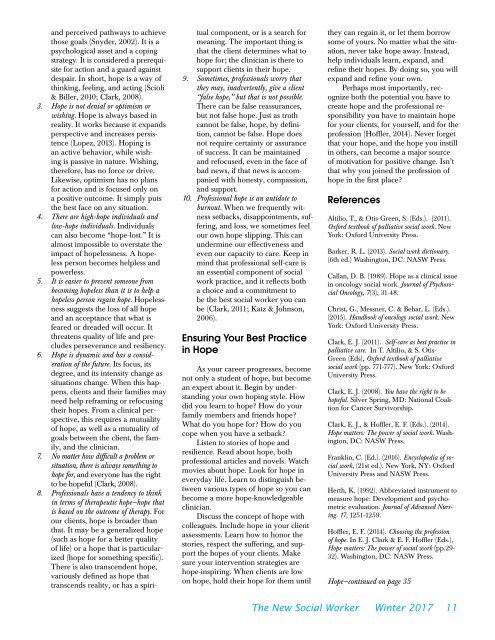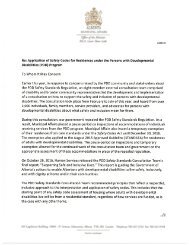In This Issue
click
click
Create successful ePaper yourself
Turn your PDF publications into a flip-book with our unique Google optimized e-Paper software.
and perceived pathways to achieve<br />
those goals (Snyder, 2002). It is a<br />
psychological asset and a coping<br />
strategy. It is considered a prerequisite<br />
for action and a guard against<br />
despair. <strong>In</strong> short, hope is a way of<br />
thinking, feeling, and acting (Scioli<br />
& Biller, 2010; Clark, 2008).<br />
3. Hope is not denial or optimism or<br />
wishing. Hope is always based in<br />
reality. It works because it expands<br />
perspective and increases persistence<br />
(Lopez, 2013). Hoping is<br />
an active behavior, while wishing<br />
is passive in nature. Wishing,<br />
therefore, has no force or drive.<br />
Likewise, optimism has no plans<br />
for action and is focused only on<br />
a positive outcome. It simply puts<br />
the best face on any situation.<br />
4. There are high-hope individuals and<br />
low-hope individuals. <strong>In</strong>dividuals<br />
can also become “hope-lost.” It is<br />
almost impossible to overstate the<br />
impact of hopelessness. A hopeless<br />
person becomes helpless and<br />
powerless.<br />
5. It is easier to prevent someone from<br />
becoming hopeless than it is to help a<br />
hopeless person regain hope. Hopelessness<br />
suggests the loss of all hope<br />
and an acceptance that what is<br />
feared or dreaded will occur. It<br />
threatens quality of life and precludes<br />
perseverance and resiliency.<br />
6. Hope is dynamic and has a consideration<br />
of the future. Its focus, its<br />
degree, and its intensity change as<br />
situations change. When this happens,<br />
clients and their families may<br />
need help reframing or refocusing<br />
their hopes. From a clinical perspective,<br />
this requires a mutuality<br />
of hope, as well as a mutuality of<br />
goals between the client, the family,<br />
and the clinician.<br />
7. No matter how difficult a problem or<br />
situation, there is always something to<br />
hope for, and everyone has the right<br />
to be hopeful (Clark, 2008).<br />
8. Professionals have a tendency to think<br />
in terms of therapeutic hope—hope that<br />
is based on the outcome of therapy. For<br />
our clients, hope is broader than<br />
that. It may be a generalized hope<br />
(such as hope for a better quality<br />
of life) or a hope that is particularized<br />
(hope for something specific).<br />
There is also transcendent hope,<br />
variously defined as hope that<br />
transcends reality, or has a spiritual<br />
component, or is a search for<br />
meaning. The important thing is<br />
that the client determines what to<br />
hope for; the clinician is there to<br />
support clients in their hope.<br />
9. Sometimes, professionals worry that<br />
they may, inadvertently, give a client<br />
“false hope,” but that is not possible.<br />
There can be false reassurances,<br />
but not false hope. Just as truth<br />
cannot be false, hope, by definition,<br />
cannot be false. Hope does<br />
not require certainty or assurance<br />
of success. It can be maintained<br />
and refocused, even in the face of<br />
bad news, if that news is accompanied<br />
with honesty, compassion,<br />
and support.<br />
10. Professional hope is an antidote to<br />
burnout. When we frequently witness<br />
setbacks, disappointments, suffering,<br />
and loss, we sometimes feel<br />
our own hope slipping. <strong>This</strong> can<br />
undermine our effectiveness and<br />
even our capacity to care. Keep in<br />
mind that professional self-care is<br />
an essential component of social<br />
work practice, and it reflects both<br />
a choice and a commitment to<br />
be the best social worker you can<br />
be (Clark, 2011; Katz & Johnson,<br />
2006).<br />
Ensuring Your Best Practice<br />
in Hope<br />
As your career progresses, become<br />
not only a student of hope, but become<br />
an expert about it. Begin by understanding<br />
your own hoping style. How<br />
did you learn to hope? How do your<br />
family members and friends hope?<br />
What do you hope for? How do you<br />
cope when you have a setback?<br />
Listen to stories of hope and<br />
resilience. Read about hope, both<br />
professional articles and novels. Watch<br />
movies about hope. Look for hope in<br />
everyday life. Learn to distinguish between<br />
various types of hope so you can<br />
become a more hope-knowledgeable<br />
clinician.<br />
Discuss the concept of hope with<br />
colleagues. <strong>In</strong>clude hope in your client<br />
assessments. Learn how to honor the<br />
stories, respect the suffering, and support<br />
the hopes of your clients. Make<br />
sure your intervention strategies are<br />
hope-inspiring. When clients are low<br />
on hope, hold their hope for them until<br />
they can regain it, or let them borrow<br />
some of yours. No matter what the situation,<br />
never take hope away. <strong>In</strong>stead,<br />
help individuals learn, expand, and<br />
refine their hopes. By doing so, you will<br />
expand and refine your own.<br />
Perhaps most importantly, recognize<br />
both the potential you have to<br />
create hope and the professional responsibility<br />
you have to maintain hope<br />
for your clients, for yourself, and for the<br />
profession (Hoffler, 2014). Never forget<br />
that your hope, and the hope you instill<br />
in others, can become a major source<br />
of motivation for positive change. Isn’t<br />
that why you joined the profession of<br />
hope in the first place?<br />
References<br />
Altilio, T., & Otis-Green, S. (Eds.). (2011).<br />
Oxford textbook of palliative social work. New<br />
York: Oxford University Press.<br />
Barker, R. L. (2013). Social work dictionary.<br />
(6th ed.) Washington, DC: NASW Press.<br />
Callan, D. B. (1989). Hope as a clinical issue<br />
in oncology social work. Journal of Psychosocial<br />
Oncology, 7(3), 31-48.<br />
Christ, G., Messner, C. & Behar, L. (Eds.).<br />
(2015). Handbook of oncology social work. New<br />
York: Oxford University Press.<br />
Clark, E. J. (2011). Self-care as best practice in<br />
palliative care. <strong>In</strong> T. Altilio, & S. Otis-<br />
Green (Eds), Oxford textbook of palliative<br />
social work (pp. 771-777). New York: Oxford<br />
University Press.<br />
Clark, E. J. (2008). You have the right to be<br />
hopeful. Silver Spring, MD: National Coalition<br />
for Cancer Survivorship.<br />
Clark, E. J., & Hoffler, E. F. (Eds.). (2014).<br />
Hope matters: The power of social work. Washington,<br />
DC: NASW Press.<br />
Franklin, C. (Ed.). (2016). Encyclopedia of social<br />
work, (21st ed.). New York, NY: Oxford<br />
University Press and NASW Press.<br />
Herth, K. (1992). Abbreviated instrument to<br />
measure hope: Development and psychometric<br />
evaluation. Journal of Advanced Nursing.<br />
17, 1251-1259.<br />
Hoffler, E. F. (2014). Choosing the profession<br />
of hope. <strong>In</strong> E. J. Clark & E. F. Hoffler (Eds.),<br />
Hope matters: The power of social work (pp.29-<br />
32). Washington, DC: NASW Press.<br />
Hope—continued on page 35<br />
The New Social Worker Winter 2017 11




